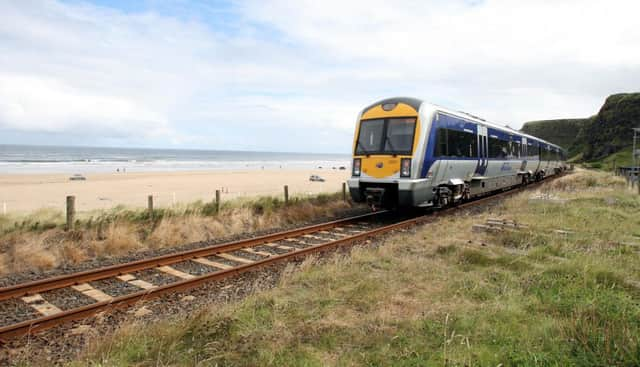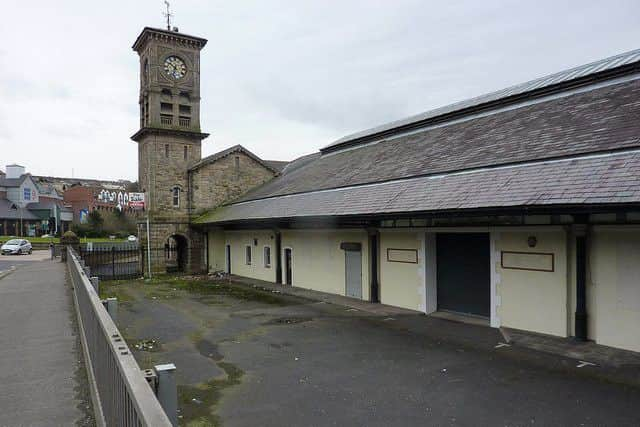What future for Derry's railway?


It’s easy to forget that Derry was once a regional railway hub - with four stations, lines stretching in all directions and a network of stops throughout its hinterland.
By the mid-1960s a mixture of antipathy towards rail, passion for roads, and arguably a Stormont desire to see the west of the province isolated, had led to three of those stations and linesbeing closed.
Advertisement
Hide AdAdvertisement
Hide AdDerry’s sole remaining station is now the most isolated on the entire Northern Ireland rail network. You have to travel for 21 miles (and 23 minutes) before you reach our nearest neighbouring station, in the tiny village of Bellarena. That is despite the track going past a hospital, a sea port and a regional airport on its way there.


In contrast - places like Coleraine, Ballymena and Lisburn all have a network of surrounding train stations which make rail a viable option for people wishing to commute into and around those towns.
The disparity in rail provision between the east and west of Northern Ireland is stark. Of the North’s 53 stations, only three are situated west of the Bann. When towns across the west lost their railways in the 1960s, they were promised replacement motorways to make amends. Fifty years on and those roads have yet to appear. Meanwhile, as usual, it’s Greater Belfast that contains the lion’s share of the North’s railway infrastructure, with more than 30 stations.
When it comes to transport, Northern Ireland has essentially been re-partitioned on an east-west basis.
Advertisement
Hide AdAdvertisement
Hide AdThe perfect opportunity to address this rail imbalance arose in 2014 when Stormont published its ‘Railway Investment Prioritisation Strategy’ to map out rail’s future for the next 20 years. On a positive note, the document reaffirmed the Assembly’s commitment to the long-overdue upgrade of the Derry to Coleraine track (which has now been completed). But, when it came to the possibility of opening new railway lines and stations, all of its suggestions focused on new services travelling to and around Belfast. Only one proposed new line reached west of the Bann – and that only as far as Dungannon (which already has the only motorway section in the west).


It’s telling that, whilst other parts of NI are being offered potential rail expansion, the only crumbs thrown to the north-west are that we’ll finally get an acceptable track and an hourly service to Belfast – something which Coleraine and stations eastwards have enjoyed for decades. The Into the West campaign group deserve credit for having been the sole voice challenging this situation in Derry in recent years.
In contrast, our Council and Assembly members appear to have done little to address the deepening rail imbalance that this strategy now guarantees for the next twenty years.
Further evidence of Derry being left behind on rail is provided in the EU’s TEN-T Network strategy - the EU’s plan for integrated road, rail and seaport connections across the continent. TEN-T has designated the Belfast to Cork (via Dublin) route as a ‘Core Network Corridor’, with Limerick included as a secondary connection. No mention is made of Derry anywhere in the entire strategy - despite the fact that the slow and infrequent Derry to Belfast route already attracts three times more passengers than the fast and frequent Belfast to Dublin service. Or the fact that Derry is not only larger than Limerick but also a regional capital. Whilst the numerous TEN-T strategy maps for Ireland highlight towns like Athlone, Portlaoise, Larne and Tralee, not a single one names Derry or even identifies that we have a port. We are literally not even on the map when it comes to the Europe-wide strategy for transport.
Advertisement
Hide AdAdvertisement
Hide AdAdmittedly, it’s not all doom and gloom for Derry’s rail future. It was announced recently that an hourly train service to Belfast will finally begin this summer and that our inadequate railway station will be replaced by 2020. However, even whilst railway infrastructure improves here, investments made elsewhere conspire to keep us as the poor relation.


Much has been made of the creation of a new £26m ‘Multi-model Transport Hub’ at the old Waterside railway building. But its grandiose title masks the fact that this new facility will be essentially a train station with a car park, bicycle locks and a bus turning circle. Local people who supported the re-use of the old historic station will doubtless be disappointed when they discover that trains will not even be able to enter the refurbished building – stopping alongside it instead.
Compare this to what is in-store for Belfast, where £175m is being spent creating the ‘Belfast Transport Hub’ at Great Victoria Street station. That development will ensure Belfast continues to offer genuine high quality multi-modal transport via an integrated bus and rail station. In contrast, Derry’s train station will remain
a 15 minute walk from its bus station. It seems that every small step forward granted to Derry’s inadequate rail infrastructure is continually out-trumped by giant leaps forward for facilities east of the Bann.
Advertisement
Hide AdAdvertisement
Hide AdIt would be selling Derry short to accept an hourly train service and a slightly better station as ‘mission accomplished’ for our railway. Instead, I believe the city must now push on to the next level of demands – aimed at ensuring rail can offer a partial alternative to car travel here. Rather than just accept the lack of other stations within 21 miles of Derry, we should be pushing for the introduction of new viable stations on the existing line to Belfast as the start of a local commuter network. And by alternating the new hourly Belfast trains between an express service with few stops, and a regular service covering all stations, it could be done in a way which wouldn’t impact the speed of journeys.


The obvious location for the first new station would be a ‘Foyle Parkway’ at City of Derry Airport (CoDA) - fulfilling three distinct roles.
Firstly, it would make CoDA the ONLY airport in Ireland connected to the rail network. That would increase its catchment area and viability, not to mention its market value for a council that’s been trying to sell it for years.
Secondly, incorporating a ‘Park and Rail’ element within that new train station would increase passenger numbers whilst reducing congestion in Derry city centre, particularly during large events like Halloween and the Clipper Festival.
Advertisement
Hide AdAdvertisement
Hide AdThirdly, ensuring such a station was easily accessible from Eglinton would enable people in that fast-growing area to commute into Derry by rail. I believe there is a strong case to be made for such a new three-function Foyle Parkway station at CoDA, and I would urge the council and local MLAs to push for a full feasibility study on the idea.
Other locations on the existing train line could also merit consideration for new stations.
With 750 civil service jobs being decentralised to Ballykelly, and the line passing through the former airbase and Shackleton Barracks development sites there, the return of a station to Ballykelly could prove viable. As potentially could a new station serving Strathfoyle and the Port of Derry - supporting the creation of further employment and housing in that part of the city.
The time has come to demand an end to third-class rail provision in Northern Ireland’s second city. With our existing track finally fit for purpose we should now explore the creation of a network of new local stations which will help create additional employment and housing zones, provide a partial alternative to the congestion that is slowly strangling our town, and enable rail to genuinely serve Derry’s needs again for the first time in half a century.